What is Mortgage Prequalification?
Imagine you’re planning a big trip and want to know your budget before booking anything. Mortgage prequalification is like that, but for buying a house. It’s a preliminary step where a mortgage lender gives you an educated guess about how much money they might be willing to lend you.
They base this estimate on the financial information you provide, such as your income, savings, debts, and a general overview of your credit history. Think of it as a quick chat with the bank to see if you’re in the ballpark for a mortgage.
How Does Mortgage Prequalification Work?
The process is generally straightforward:
- Gather Information: You’ll provide details about your income (pay stubs, tax returns), existing debts (credit cards, car loans, student loans), assets (savings and checking accounts), and employment history.
- Lender Assessment: The lender reviews this information to get a general sense of your financial health and borrowing capacity. They might also do a quick check of your credit report, often called a “soft inquiry,” which doesn’t impact your credit score.
- Receive an Estimate: Based on this review, the lender will give you a prequalification letter stating the estimated loan amount you might qualify for.
It’s important to remember that prequalification is not a loan commitment. It’s a preliminary estimate, and the actual loan amount you can borrow will be determined after a full mortgage application and underwriting process.
Mortgage Prequalification vs. Mortgage Pre-approval
This is where it often gets confusing, so let’s clear it up!
- Prequalification: An estimate based on information you tell the lender. It’s quick and easy but not a guarantee.
- Pre-approval: A more rigorous process where the lender verifies all the information you provide (income, assets, employment, credit history) by pulling your credit report and requesting documentation. A pre-approval letter shows sellers you’re a serious buyer and have a stronger chance of getting the loan.
Think of prequalification as window shopping for a loan, and pre-approval as actually trying on the outfit and getting the price confirmed.
Why is Mortgage Prequalification Important?
Getting prequalified offers several advantages when you’re on the hunt for a home:
- Budgeting: It gives you a realistic price range for homes, so you don’t waste time looking at properties outside your means.
- Shopping Power: It signals to real estate agents and sellers that you’re a serious buyer who has taken the initial steps.
- Identifying Issues: It can highlight potential credit issues or financial gaps early on, giving you time to address them before applying for a full mortgage.
- Streamlining the Process: While not as strong as pre-approval, it’s a good first step that can make the subsequent pre-approval process smoother.
Who Does Mortgage Prequalification Affect?
- First-Time Homebuyers: It’s especially helpful for those new to the home-buying process, as it provides an early understanding of their financial standing for a mortgage.
- Homebuyers with Varied Credit: If your credit history isn’t perfect, prequalification can give you an idea of what loan options might be available.
- Anyone Planning a Home Purchase: Regardless of your financial background, understanding your potential borrowing power upfront saves time and effort.
Tips for Mortgage Prequalification
- Shop Around: Get prequalified by a few different lenders to compare estimates and terms.
- Be Honest: Provide accurate information. Misrepresenting details can lead to problems later.
- Don’t Max Out Credit: Avoid making large purchases or opening new credit accounts between prequalification and your full mortgage application, as this can affect your credit score and debt-to-income ratio.
- Aim for Pre-approval: While prequalification is a good start, aim for mortgage pre-approval for a stronger position in the market.
Common Misconceptions
A common misconception is that prequalification is the same as pre-approval, or that it guarantees you’ll get the loan. Remember, it’s just an estimate based on the information you’ve provided, and the lender hasn’t fully verified everything yet.
Sources
- What Is Mortgage Prequalification? – Consumer Financial Protection Bureau
- Mortgage Prequalification vs. Pre-approval – NerdWallet
- What is Mortgage Prequalification? – Investopedia
